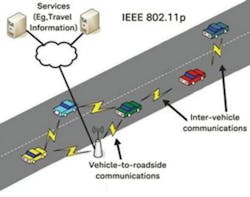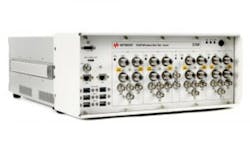Software plus signal generators and analyzers support IEEE 802.11p design and test
IEEE 802.11p is an extension to the IEEE 802.11 standards that adds wireless access in vehicular environments. Jungik Suh, marketing program manager, Automotive & Energy Solutions, Keysight Technologies, provided input on several Keysight solutions for the connected-car arena for our October print special report on automotive test. In addition, he provided extensive information on Keysight’s approach to 802.11p, as described below.
Keysight’s offerings include SystemVue electronic system level (ESL) design software and ADS software as well as signal-generation and -analysis solutions for 802.11p. Keysight, Suh said, provides various solutions to help customers solve challenges across the entire design and test lifecycle for the connected car. “For the early research and development stage, efficient designing of the 802.11p device’s PHY layer requires appropriate modeling and simulation,” he said. “To enable this, Keysight offers powerful design tools solutions, including SystemVue, Advanced Design System (ADS), and GoldenGate software platforms.”
Suh cited SystemVue ESL design software for system-level modeling and simulation. “SystemVue is a communications design environment that can be used to create working 802.11p waveforms, which can be uploaded to an arbitrary waveform generator (AWG) and used to modulate an RF signal generator,” he said. “Using it, designers can verify and make trade-offs between the device’s baseband algorithms and system performance with faded and precisely impaired channels and various RF components. SystemVue brings together PHY baseband algorithmic modeling, accurate RF modeling, standards-based reference intellectual property (IP), and direct interaction with test equipment. Used early in the R&D lifecycle, it follows both the RF and baseband design paths into implementation, providing continuity for cross-domain verification.”
He added that SystemVue helps simplify the 802.11p device development process by enabling validation of early RFIC and MMIC designs in ADS and GoldenGate, prior to tape out. “It also provides economical system-level validation and high-fidelity early precompliance using simulations, so final hardware-compliance testing can be performed more quickly and with greater confidence,” he added. “Finally, it enables generation of consistent test vectors for simulation versus hardware testing.”
He continued, “Like SystemVue, ADS helps designers develop and share customized models prior to performing simulations to better understand performance and the impact of different devices. However, while SystemVue works at the system level, ADS targets device simulation and is extensively used in R&D. The GoldenGate RFIC simulation software platform provides yet another avenue for engineers to look at simulated performance data, before a prototype is even available. SystemVue, ADS, and GoldenGate include links to Keysight’s measurement-hardware-compatible signal-generation and signal-analysis applications” (for example, Signal Studio software for signal generation and 89600 VSA software for signal analysis).
Suh noted that it is essential to verify the 802.11p transmitter and receiver performance during R&D. 802.11p transmitter measurements are needed to analyze the physical parameters of the 802.11p signal generated from a DUT to verify its transmit characteristics and compliance with required standards. Parameters include channel power, occupied bandwidth, center frequency, symbol clock tolerance, and modulation accuracy. Signals must also comply with spectrum emission masks (SEM) defined by IEEE, FCC, and ETSI.
In addition, 802.11p receiver test measures minimum input sensitivity, adjacent channel rejection, nonadjacent channel rejection, and maximum input level; also necessary are clear channel assessment and received channel power indicator measurements. “Some of the requirements are the same as those for 802.11a,” Suh said. “However, 802.11p defines much stricter requirements for adjacent and nonadjacent channel rejection. (For example, 802.11p adjacent channel rejection requires 12 dB stricter performance compared to the requirements of 802.11a). More importantly, 802.11p designers need to verify the performance of their receiver under fading conditions because 802.11p is designed for communication within a vehicular environment with mobility.” Finally, he added, the IEEE 802.11-14/0259r0 document, an amendment to the 802.11 standard, specifies 802.11 V2V radio channel models for fading conditions that can be used during simulation with a few scenarios including rural line-of-sight (LOS), urban approaching LOS, street crossing non-line-of-sight (NLOS), highway LOS, and highway NLOS.
Suh said Keysight offers several accurate and flexible signal-generation and signal-analysis solutions to test 802.11p transmitter and receiver. “For receiver test including the fading environment, we provide a signal-generation solution that comprises the N7617B Signal Studio for WLAN 802.11a/b/g/j/p/n/ac/ah software and a vector signal generator (N5182B MXG or N5172B EXG X-Series signal generators, E8267D PSG, or M9381A PXIe VSG),” he said. “The signal-analysis solution is made up of the 89601B vector signal analysis (VSA) software with WLAN Modulation Analysis for 802.11a/b/g/p/j (89601B VSA Option B7R) and the X-Series signal analyzers with N9077 WLAN 802.11a/b/g/j/p/n/ac/ah Measurement Application. Together, these signal-generation and -analysis solutions address and exceed the stringent requirements of 802.11p physical-layer tests. Signal generation is enabled by the Signal Studio for WLAN and vector signal generators such as the MXG or EXG.”
For design verification and manufacturing tests for the 802.11p transmitter and receiver testing, Suh said, “Keysight’s E6640A EXM wireless test set provides the functionality needed in a single box. The EXM one-box tester is optimized for multidevice testing with up to four transmit/receive units (TRX’s) loaded into a PXI mainframe. Each TRX consists of a complete vector signal analyzer, vector signal generator, and calibrated RFIO that can be used to easily test multiformat devices. The EXM can be configured to test cellular products with a standard 40 MHz of analysis bandwidth and/or WLAN products with up to 160 MHz of analysis bandwidth to support the current and future wireless connectivity technologies. EXM also provides multi-satellite GNSS test.”
Suh also noted that Keysight’s portfolio of automotive solutions now includes Anite automotive design and test tools:
- Virtual Drive Testing Toolset, a lab-based automated performance and interoperability test solution that accelerates product development and reduces the need for extensive vehicle field testing;
- WLAN Toolkit to conduct comprehensive V2X WLAN testing by reproducing vehicle ad hoc networks (VANET) created from car convoys on highways as well as car–to-traffic light configurations; and
- over-the-air (OTA) performance testing to assess the end-user experience by replicating real-world radio network conditions as seen by the vehicle antenna cluster.
He added that in addition to the connected car design and test solutions, Keysight also offers automotive applications addressing automotive radar, body and security, power train, battery, power converter, and power semiconductors.
Finally, he said, the company offers design and test solutions for 5G, “which will play important role of future V2X/V2I applications as well as the autonomous driving car. Keysight offers various 5G early research design and test solutions, including an industry’s first 5G Exploration Library for researchers.”



